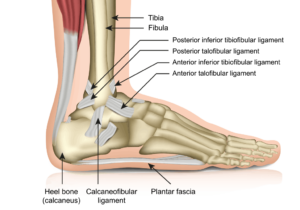An injury to the syndesmosis ligaments is also called a high ankle sprain. The severity of the sprain depends on the extent of the tear.
Damage to these ligaments leads to a loss of stability at the bottom of the shin and particularly the ankle, often resulting in reduced ankle joint movement, reduced balance, stability and power. Possible long-term effects of this injury can include degenerative changes such as arthritis.
Syndesmosis injuries account for 11% of all ankle injuries but have a higher occurrence among athletes that play contact sports involving fast changes in direction, twisting or cutting manoeuvres such as football, rugby and basketball.

An example of how a syndesmosis injury can occur is when the foot is firmly planted, then the leg rotates internally. This can cause external rotation of the talus, a bone in the lower part of the ankle joint above the heel bone, which can tear the ligament and cause the tibia and fibula to separate.
This type of injury commonly involves force and is often accompanied by injuries to other ligaments, tendons or bones. One or more bone fractures may also be associated with a syndesmosis sprain.
Symptoms that set this injury apart from a normal ankle sprain usually include:
An ankle syndesmosis injury effects the fibrous joint held together by ligaments. It is located above the ankle joint between the tibia (large shin bone) and the distal fibula (outside leg bone).
Its primary function is to provide strong stabilisation and support around the distal part of the ankle and provide shock absorption for running and jumping. There should be little movement between the tibia and fibula due to the strength of this ligament and others around it.
Initial management of the injury involves offloading and protecting the injured tissues. Ice can help to reduce the swelling and a moon boot and crutches prevent movement at the ankle and avoids placing weight through the foot and ankle.
A mild ligament tear requires immobilisation followed by a progressive rehabilitation plan to restore strength, balance and dynamic function of the foot and ankle. It can take up to 8-12 weeks for a patient to fully recover.
Due to the overall influence a syndesmosis injury has on the ankle’s structural stability and function, it could require greater invention by way of surgery.
Surgery can stabilise the two shin bones as well as repair any fractures that may have also occurred due to the injury. Often screws and plates are used to realign the bones and offer structural stability to the joint for the long term.
If you are looking to book an appointment, please call us on